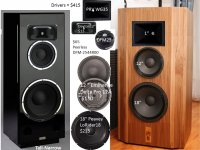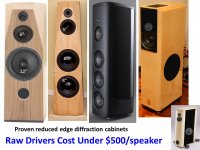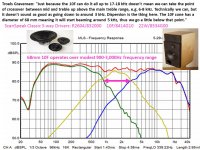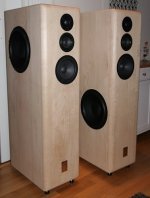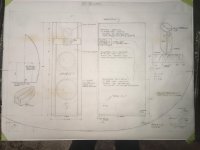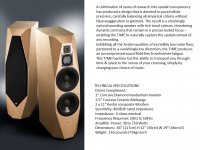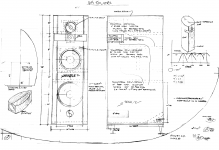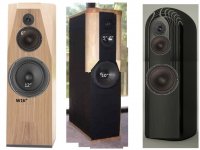Offshore64, You have selected four excellent(low Le, modest cone break-up, vented) drivers which should integrate well in your cabinet with low complexity DSP functions. The 10F/4424G simulates to a max SPL ~104db @1m, probably not an ideal BIG room midrange.
=========BIG speakers
You can purchase excellent BIG, big room speakers for around $400/speaker. 18" woofer + 12" midrange + 1" compressions driver + 1" controlled directivity waveguide
=========Edge diffraction
DSP cannot remove cabinet edge diffraction effects. A large multi-amp DSP investment deserves a cabinet with proven low edge diffraction.
Rounding the sides of a cabinet can reduce internal low frequency resonances, but edge diffraction distortion still remains if the front baffle edges are not treated with bevels/rounds.
=========BIG room Midrange
The ScanSpeak 10F/4424G has a 68mm cone diameter, 20W max power, and sealed box T/S parameters which favor a crossing over 500Hz. Not an ideal BIG room midrange.
Troels Gravensen: "Just because the 10F can do it all up to 17-18 kHz doesn't mean we can take the point of crossover between mid and treble up above the main treble range, e.g. 6-8 kHz. Technically we can, but it doesn't sound as good as going down to around 3 kHz. Dispersion is the thing here. The 10F cone has a diameter of 68 mm meaning it will start beaming around 5 kHz, thus we go a little below that point." Troels uses -3db @900Hz -to- 3,000Hz for the ScanSpeak 10F
=========3-way with Satori MR16-4
A 5" or 6" midrange will deliver greater dynamics and higher max SPL, and also cover more of the vocal range without a crossover discontinuity.
STUDY: Satori MR13P-4 with 2.4kHz Xover, and MR16P-4 with 2kHz crossover.
For a BIG room, you will find well-reviewed 3-way designs using the MR16P-4 crossed to a couple 8" or one 12" woofer.
=========BIG speakers
You can purchase excellent BIG, big room speakers for around $400/speaker. 18" woofer + 12" midrange + 1" compressions driver + 1" controlled directivity waveguide
=========Edge diffraction
DSP cannot remove cabinet edge diffraction effects. A large multi-amp DSP investment deserves a cabinet with proven low edge diffraction.
Rounding the sides of a cabinet can reduce internal low frequency resonances, but edge diffraction distortion still remains if the front baffle edges are not treated with bevels/rounds.
=========BIG room Midrange
The ScanSpeak 10F/4424G has a 68mm cone diameter, 20W max power, and sealed box T/S parameters which favor a crossing over 500Hz. Not an ideal BIG room midrange.
Troels Gravensen: "Just because the 10F can do it all up to 17-18 kHz doesn't mean we can take the point of crossover between mid and treble up above the main treble range, e.g. 6-8 kHz. Technically we can, but it doesn't sound as good as going down to around 3 kHz. Dispersion is the thing here. The 10F cone has a diameter of 68 mm meaning it will start beaming around 5 kHz, thus we go a little below that point." Troels uses -3db @900Hz -to- 3,000Hz for the ScanSpeak 10F
=========3-way with Satori MR16-4
A 5" or 6" midrange will deliver greater dynamics and higher max SPL, and also cover more of the vocal range without a crossover discontinuity.
STUDY: Satori MR13P-4 with 2.4kHz Xover, and MR16P-4 with 2kHz crossover.
For a BIG room, you will find well-reviewed 3-way designs using the MR16P-4 crossed to a couple 8" or one 12" woofer.
Attachments
I designed a round sided cabinet to eliminate parallel sides but Ive never heard about cabinet edge defraction other than tweeters being treated with felt. I shall round the face as much as the drivers will allow. Easy to do. Its 1” Maple. I figured the mid was a bit under sized (SPL) and was considering the Audax 100dB but will look at this Satori people have mentioned. I simply cannot wrap my head around how 2 8” drivers could get the range that a 8” sealed and a 10” ported could, however. Although I will be using 8ohm on the 8 & 10 as a result of earlier discussions in this thread. Not sure why yet, but I will. I honestly think I will use the 10” to about 20-70hz. Almost never. I just see my existing (Sony) towers with double 8” xo’d too low and thought I’d give this 8” a little releif and, as a sealed driver, ability to punch a little when needed.
Last edited:
After reading a baffle edge diffraction tutorial, have you found a couple cabinet designs which you want to adapt to your room, and can construct with your tools?
===
One of the major advantages of using DSP crossovers is the capability to equalize the room effects on the bass SPL at the listener. A sealed volume woofer with enough cone area and Xmax can produce deeper bass, superior sealed-transients, and require simplier bass equalization DSP functions than a ported alignment. DSP + higher_watts will support a larger cone woofer in a reasonable size sealed volume. A ported woofer would make sense if you also want a passive crossover option.
==== Sd vs. cone diameter===
18" 1220 cm2...(moving diameter 39.4cm)
15" 855 cm2...(moving diameter 33cm)
12" 530 cm2...(moving diameter 26cm)
10" 345 cm2...(moving diameter 21cm)
8" 225 cm2...(moving diameter 16.7cm)
6.5" 140cm2...(moving diameter 13.4cm)
===
One of the major advantages of using DSP crossovers is the capability to equalize the room effects on the bass SPL at the listener. A sealed volume woofer with enough cone area and Xmax can produce deeper bass, superior sealed-transients, and require simplier bass equalization DSP functions than a ported alignment. DSP + higher_watts will support a larger cone woofer in a reasonable size sealed volume. A ported woofer would make sense if you also want a passive crossover option.
==== Sd vs. cone diameter===
18" 1220 cm2...(moving diameter 39.4cm)
15" 855 cm2...(moving diameter 33cm)
12" 530 cm2...(moving diameter 26cm)
10" 345 cm2...(moving diameter 21cm)
8" 225 cm2...(moving diameter 16.7cm)
6.5" 140cm2...(moving diameter 13.4cm)
Well, from what I have read, the higher the frequency, the more one needs to consider diffraction when designing the faces and edges of a cabinet. I think, for my purposes, a few tweaks on my original cabinets will work just fine (I had yet to update the new drivers when this photo was taken). Basically beveling the 1" Maple face plinth, but notice there is very little flat surface anywhere to begin with as the cabinets are columns with a truncated ellipse cross section..
The HF drivers are in a teardrop shaped hardwood puck, the 6.5" MR sitting on top. Below is a sealed 8" for tight LF and below that is a 10" ported, for 100Hz and below.
The HF drivers are in a teardrop shaped hardwood puck, the 6.5" MR sitting on top. Below is a sealed 8" for tight LF and below that is a 10" ported, for 100Hz and below.
Attachments
With your current study of a 5" - 6" midrange, your DSP multi-amp design could shift to two sealed volume 10" woofers. Have you completed any low diffraction 3-way cabinet sketches?
Proven Avalon style cabinets are well constructed rectangular boxes with a THICK baffle to support clever bevel cuts. Constrained layer dampening can even be used on the large flat panels. With DSP, no baffle slope is required. Some DIY'ers with limited wood shops have been bevel-successful with hand saws. The top truncated pyramid is well defined, but bottom edge bevels are optional and can reflect your style. Since the bevels are confined mainly to the top section, the cabinet can be small-radius narrow around the 10" woofers.
If you favor round radius edges, you can keep the bottom woofer section of a basic box cabinet narrow by tapering the top larger radius rounds into soft edges around the woofers. A temporary ramp on the side of the cabinet can taper the round-over router cut.
Proven Avalon style cabinets are well constructed rectangular boxes with a THICK baffle to support clever bevel cuts. Constrained layer dampening can even be used on the large flat panels. With DSP, no baffle slope is required. Some DIY'ers with limited wood shops have been bevel-successful with hand saws. The top truncated pyramid is well defined, but bottom edge bevels are optional and can reflect your style. Since the bevels are confined mainly to the top section, the cabinet can be small-radius narrow around the 10" woofers.
If you favor round radius edges, you can keep the bottom woofer section of a basic box cabinet narrow by tapering the top larger radius rounds into soft edges around the woofers. A temporary ramp on the side of the cabinet can taper the round-over router cut.
Attachments
Well, from what I have read...
I have cleaned up your drawing a bit… hopefully more readable (certainly a dramatic reduction in file size).
One comment: you will be investing a significant amount in drivers, why compromise the build be using MDF?
dave
Attachments
Have you sketched any new low-diffraction cabinets which use the solid Maple you have collected? I agree with you that large-rounds just on the top-left-right edges around the tweet+midrange only above-the-woofer, and blending this into shallow-rounding the lower (plywood) edges next to the woofer is a worth a sketch-up. With good internal bracing, curving the side panels is more for appearance than for resonance performance. If you can accept flat side panels, you might also consider gluing MDF + Plywood for layer dampening. HEAVY.
American Icon. If I had a CNC I'd explore milling out the top rounds of the Juke-Box style cabinet, and use flat panels with large-to-small tapered edge rounds below.
American Icon. If I had a CNC I'd explore milling out the top rounds of the Juke-Box style cabinet, and use flat panels with large-to-small tapered edge rounds below.
Attachments
"why compromise the build be using MDF"
The use of MDF is a compromise, but in acquiring the shape, "wrapping" a form with several layers of thin MDF seems easy, free of air voids, dense as lead. With an exotic wood veneer, the whole project would be averse to high humidity. I have access to Oak and Maple. Im just not to hip on rectangles. I may switch the build to laminated 3mm Lauan sheets with exterior adhesive.
The use of MDF is a compromise, but in acquiring the shape, "wrapping" a form with several layers of thin MDF seems easy, free of air voids, dense as lead. With an exotic wood veneer, the whole project would be averse to high humidity. I have access to Oak and Maple. Im just not to hip on rectangles. I may switch the build to laminated 3mm Lauan sheets with exterior adhesive.
... "wrapping" a form with several layers of thin MDF...
It becomes a plywood, each layer. ply. Differs in that MDF does not have a direction.
PE had curved cabinet for a while that were 5 plies (IIRC) and way better than the rectangular ones, but still not up to real plywood.
dave
- Status
- This old topic is closed. If you want to reopen this topic, contact a moderator using the "Report Post" button.
- Home
- Loudspeakers
- Multi-Way
- Choosing Scanspeak Drivers for 4-way
